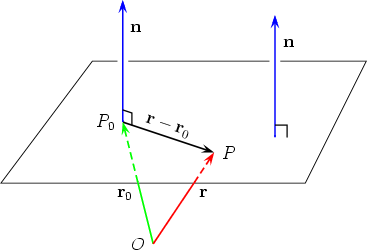 |
||||||||||||||||||||||||||||||||||||
|
13. Planes in space
|
||||||||||||||||||||||||||||||||||||
|
|
||||||||||||||||||||||||||||||||||||
|
Suppose that P0 has coordinates x0,y0,z0 and n has components a,b,c.

Let P, with coordinates x,y,z, be an arbitrary point on the plane. The position vectors of P0 and P are  and  Substituting  into the vector equation, we obtain  which, when multiplied out, gives 
This is called a Cartesian equation of the plane. It simplifies to 
where d is the constant ax0 + by0 + cz0. An equation of the form  where a,b,c and d are constants and not all a,b,c are zero, can be taken to be an equation of a plane in space. The coefficients a, b and c are the components of a normal vector  for the plane described by the equation. |
|||||||||||||||||||||||||||||||||||
| Feedback |
|
|||||||||||||||||||||||||||||||||||
© 2002-09 The University of Sydney. Last updated: 09 November 2009
ABN: 15 211 513 464. CRICOS number: 00026A. Phone: +61 2 9351 2222.
Authorised by: Head, School of Mathematics and Statistics.
Contact the University | Disclaimer | Privacy | Accessibility